CAMELLIA FOR THE UK GARDENER
Article by David Marks
Camellias are evergreen shrubs with very attractive flowers, normally in late winter / early spring. For the first two years they require some attention, watering in particular, to become established. After that they are very capable of looking after themselves. Position and soil conditions are the key factors for growing healthy Camellias.
Use the checklist below to decide if a Camellia is suited to your preferences and garden onditions.
- Need a neutral to acidic soil. They will not grow successfully in chalky soils.
- Prefer a partially shaded position which is protected from strong winds. Some varieties such as Camellia williamsii can tolerate more exposed positions.
- Flowers are easily damaged if they are grown in an east facing position.
- Younger plants will need to be watered especially in dry conditions from July to September. More established camellias are capable of looking after themselves as far as water is concerned.
- Tap water can be used occasionally with no ill effects but they really prefer more acidic rain water. A water butt is the easiest way to achieve this.
- Most flower from late winter to early spring. Camellia sasanqua flowers in mid-autumn.
- Some varieties are suited to being grown in large containers
- Size and spread at maturity varies from 2m / 6ft to 10m / 32ft so choose your variety carefully!
DIFFERENT VARIETIES OF CAMELLIA
To keep this article relevant to 95% of UK gardeners, we have restricted it to three groups, Camellia japonica, williamsii and sasanqua. There are other types but they are quite rare. At the end of this article (click here) we list the key attributes of many common camellia varieties. A general comparison between Camellia japonica, williamsii and sasanqua is given below.
CAMELLIA JAPONICA
Japonicas have been cultivated for a thousand years or more and were the first camellia to be imported to Europe. In the early 1800s plant breeders began to develop new varieties and there are now thousands of them. There are more types of Camellia japonica than any of the other groups and this is one reason for their popularity.
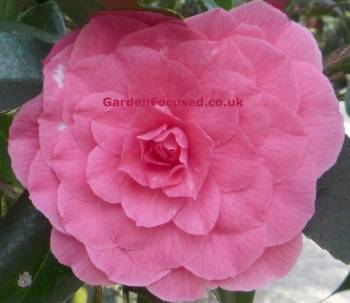
Camellia japonica ‘Eximia’
As far as the UK is concerned Camellia japonica does best in warmer areas which are protected from strong winds. The south west is provides them with an ideal climate. The cooler and windier the climate, the less chance you have of successfully growing Camellia japonica. They can of course be grown outside of the south west but they need protection and ideal conditions.
Flowers tend to be produced in one single flush in late March (later or earlier depending on the climate) which results in a single spectacular show over a relatively short time.
Height and spread varies greatly between cultivars but they are normally within the range, height and spread of 2m / 6ft to 3.5m / 11ft. Most are not the best Camellia to grow in a container.
CAMELLIA WILLIAMSI
Williamsi have a much shorter history. They are a cross between Camellia japonica and Camellia saluenensis, first appearing commercially in the late 1920s. They were originally only single flowers but over the last 40 years more showy double flowers have been bred. There are fewer williamsii varieties compared to japonica.
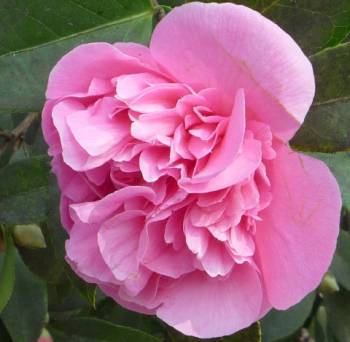
Camellia williamsii ‘Debbie’
Camellia williamsii has several advantages over japonica, the first being that they are fully hardy in almost all parts of the UK, quite capable of growing successfully in cooler areas. They also produce flowers over a longer period, from
mid March to late April. The flowers are not all produced at once more appear as others fade. This has the great advantage that if a frost damages the flowers others will soon appear.
Williamsii tend to grow more upright compared to japonica and are less susceptible to wind damage. They are also slightly smaller shrubs, most growing to a height of 2m / 6ft. Our preference between a williamsii or a japonica in the average UK garden would be for a williamsii every time.
CAMELLIA SASANQUA
Not as common as Williamsii or Japonica in the UK the Sasanqua camellias are distinguished by the flowering in early winter rather than spring. There are only a few varieties widely available and this is because they will only grow successfully outside in the South (especially the South West) of England. In cooler areas the flowers are frequently damaged by frosts.
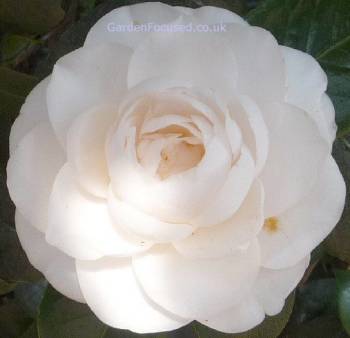
Camellia sasanqua Lucinda
They grow to a height and spread of around 2m / 6ft after ten years. The flowers are slightly scented. Sasanquas are ideal pot plants as long as they are kept in a frost free position over winter.
HOW TO PLANT A NEW CAMELLIA
Follow the steps below to ensure your camellia is planted correctly and in the best position:
- Autumn is the best time to plant a new camellia although they will do equally well with a spring planting as long as the roots are kept moist in early summer when the weather warms up.
- Choose a partially shaded position. The shade, if possible should protect the plants from the early morning sun. What really damages camellia buds and flowers is the combination of a frosty night and sun-filled early morning. The sudden change from cold to warm is most damaging.
- Choose a position protected from strong winds.
- The soil should be slightly acidic if possible. A neutral soil can be enhanced by the addition of ericaceous compost but an alkaline, chalky soil will always be an uphill battle for the health of your camellia.
- To plant a new camellia dig a hole roughly twice the size of the rootball. Add some ericaceous compost and a handful of blood fish and bone into the hole to half-fill it. With a trowel mix the compost and blood, fish and bone into the soil at the base of the hole.
- Plant the camellia to the same depth as it was in the pot, gently firming it into the surrounding soil. Put a stake into the ground to support the new plant, in the first couple of years they are prone to breaking off in strong winds. Gently tie the camellia to the stake. Water in well.
- Provide rabbit protection if needed. Rabbits love camellia plants especially when the plants are young. The only protection which really works is wire mesh around the base of the plant. This can be removed (as can the stake) after two to three years when the plants have grown stronger.
HOW TO CARE FOR YOUR CAMELLIA
When camellias become established they are easy to care for although they do need to be looked after for the first couple of years of their life.
ONGOING CARE OF CAMELLIAS
The two key requirements of are a regular supply of water at specific times of the year and a good supply of nutrients in spring and summer. These are particularly important in the first three years of the plant’s life, after that the roots will have spread sufficiently deep and wide for them to look after themselves in all but very dry conditions.
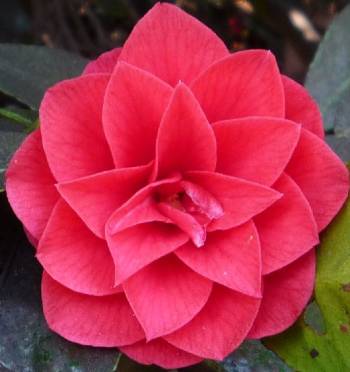
Camellia japonica Forest Green
WATERING CAMELLIAS
In their native countries (China, Japan and South Korea) Camellias receive lots of rainfall from spring and through summer but almost none from mid autumn through to the next year. Try to mimic that need for water in your own garden. In the UK your plants may well need watering from early to late summer if the conditions are dry especially in the firs three years of their life. In drier parts of the world such as parts of Australia and the USA the plants may need watering more frequently.
The flower buds for the next year begin to form in early July and that is the key period for water, if the plants are deprived of water at this time the flowers will affected for the next year.
Camellias prefer slightly acidic soil and rainwater is exactly that. Tap water tends to be alkaline and is not the best source of water for acid loving plants. If you will need to water frequently because you live in a low rainfall area, a water butt collecting rainfall is by far the best solution. Occasional use of tap water won’t harm the plants but continuous use will.
FEEDING CAMELLIAS
The time for feeding young camellia plants matches their need for water. We strongly recommend a twice yearly feed ofblood, fish and bone in spring and early summer (two handfuls per plant each time). We do not recommend the use of quick fix nitrogen fertilisers which can encourage the growth of lots of weak foliage. Do not feed the plants from mid August to late January.
When the plants get to three or four years they should be able to look after themselves (in the UK) as far as water and feeding are concerned. In very warm and dry summers a good drenching with water will help them form buds and growth for the next year.
PRUNING CAMELLIAS
Pruning camellias, if needed at all, is an easy task. The best time is immediately after the flowers have faded normally in spring. You can prune later in the year but you will in all probability remove some buds which would form flowers next year.
For the first four years there will be no need to prune your camellia, it’s best to leave it to its own devices to build up strength. After that we recommend two pruning actions each year:
- Clear all stems from the lower part of the main trunk so that the lower 15cm – 25cm (dependent on the height of the plant) of the main stem is clear of growth. This will prevent any stems touching the ground and picking up diseases.
- Thin out the central part of the plant removing any thin and wispy growth. This will prevent the centre area from becoming congested, air circulation will be improved.
The only other pruning will be to keep the plant in shape and to the size you want. An established camellia will tolerate drastic pruning with no long term effects. So, pruning to shape is entirely up to you, there are no special technique required.
GROWING CAMELLIAS IN CONTAINERS
Camellias can be grown in containers although they do need a bit of care in the winter. Potted plants are more susceptible to frost damage compared to those in the ground so we recommend placing your potted Camellia in a porch, open garage or in a protected position up against the house during the winter – November to March ideally. If the weather is predicted to be really cold then they can be temporarily moved into a garage for a week or so. The lack of light is not ideal but will have no visible affect if limited to a week or so.
The other consideration with growing Camellias in pots is size, both the size of the container and the size of the shrub. The larger the container the better for you and your plants because large containers require less frequent watering.
Plant in ericaceous compost using a container size (width) of about 40cm / 16in. The larger the container, within reason, the better. Container grown plants dry out easily in warm weather and may need watering two or more times a week in very warm weather.
A handful of
blood, fish and bone fertiliser every month from April to August will provide sufficient nutrients for a healthy plant. An excellent alternative is long-lasting feed for acid loving plants available at large garden centres and diy stores. Normal nitrogen fertilisers should not be used.
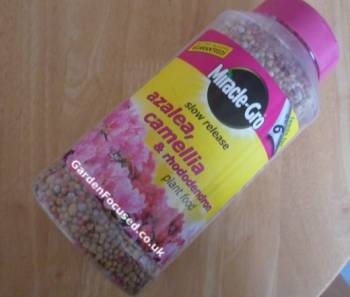
Camellias in containers will need to be watered with rain water to maintain the acidity of the compost. We recommend using water from a water butt. Tap water can be used in an emergency and it is better than allowing the plants to dry out.
CAMELLIA PESTS AND DISEASES
Camellias are healthy plants in general and the few pests and problems they do suffer from are relatively easy to treat.
SOOTY MOULD
The symptoms are easy to identify. The leaves are covered in a black sooty like substance,
this normally occurs from late April to late June.
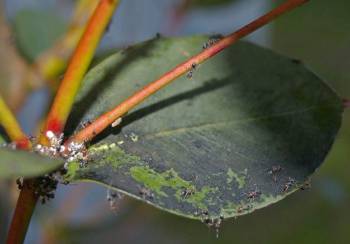
It is normally caused by scale insects on camellias or less frequently aphids. These secrete a sweet sticky substance as they feed on the leaves. This settles and because it is sugary, it attracts fungi which cause the black sooty material. This is unsightly but rarely causes much damage.
The cure, if you have only a small camellia, is to wash it off (with the aphids) by hand using slightly soapy water – a couple of drops of washing up liquid per pint of water. Larger plants can can be sprayed with water which will wash off many of the aphids and some of the sooty mould. For more details on aphids see our article
here.
CAMELLIA LEAF BLIGHT
The symptoms are light to dark brown areas on the leaves typically starting at the leaf tip and spreading up the leaf to the stem. The browned areas appear to be slightly greasy. Eventually the affected leaves will fall off.
There is no chemical treatment for this fungal disease however it tends to attack weak plants where there are damp conditions. The best course of action is follows:
- Collect and burn infected leaves, especially fallen debris under the plant.
- Avoid damp conditions by allowing good air circulation through the centre of the plant. Thin out the central part of the plant removing any thin and wispy growth.
- Keep the plant in good condition by following our watering and feeding instructions given
earlier in this article.
CAMELLIA FLOWER BLIGHT
The symptoms are light to dark brown areas on the petals. These typically start at the edges of the flowers but within 36 hours it will have spread to the centre of the flower and shortly afterwards they drop off. There is no chemical treatment available. This fungus started to affect camellias in southern England in 1999. The infection can be distinguished from frost damage by the way it travels to the centre of the flowers so quickly. The fungal infection is caused by spores which can travel on the wind for several miles, they can also move from place to place on shoes and garden implements. This is a difficult problem to cure but the following may help:
- The spores come from fungi which grow vigorously in the soil. Lay down a barrier around and underneath plant such as cardboard, newspaper ten layers thick or similar and cover with 5cm / 2in of mulch. This will stop the fungi growing and hopefully kill them after some years. Repeat each year for five years.
- Collect and burn infected leaves, especially fallen debris under the plant.
- Avoid damp conditions by allowing good air circulation through the centre of the plant. Thin out the central part of the plant removing any thin and wispy growth.
- Keep the plant in good condition by following our watering and feeding instructions given earlier in this article.
RECOMMENDED VARIETIES OF CAMELLIA
There are hundreds of varieties of camellias, some have quite rightly stood the test of time and some new ones have great promise. We identify some of those which can readily be obtained.
SASANQUA CRIMSON KING
A tried and tested variety in the British climate. It’s never going to thrive in the coldest parts of the country but, at the same time, it does well even in the Midlands.
- Simple, single flowers, deep crimson with very prominent golden stamens, a very slight scent
- Flowering time October to November
- Height and spread 2m / 6ft
- Overall shape is semi-upright and open
- Leaves are glossy green and evergreen
- RHS Award of Garden Merit in 1993, reconfirmed in 2012
- Hardy down to -5°C, a couple of degrees lower if planted in a favourable position (see here above).
- Our online recommended supplier of Sasanqua Crimson King is Trehane
Nursery.
Click here to visit their page and buy online.
SASANQUA HUGH EVANS
An ideal plant for growing against a wall. The spreading shape allows it to be easily tied in if needed. Will stand a few degrees of frost but this is really a variety for warmer parts of the UK.
- Single pink flowers with very prominent golden stamens, a very slight scent
- Flowering time late October to early December
- Height 3.5m / 11ft, spread 2m / 6ft
- Overall shape is spreading
- Leaves are glossy green and evergreen
- RHS Award of Garden Merit in 2002, reconfirmed in 2012
- Hardy down to -5°C, at risk of significant damage in cold winters.
SASANQUA JEAN MAY
The flowers are delicate and very attractive. The scent is almost non-existent and not particularly good.
- Delightful semi-double, light pink flowers with light orange centre which appears as the
flowers open - Flowering time late October to early December
- Height and spread 3m / 10ft
- Overall shape is semi-upright and open
- Leaves are glossy green and evergreen
- RRHS Award of Garden Merit in 2002, reconfirmed in 2012
- Hardy down to -5°C
SASANQUA NARUMIGATA
Larger at maturity than most other Sasanquas, this is a stately plant which grows to the size of a small, bushy tree.
- White single flowers with a slight pink tinge. Golden stamens at the centre, visible when the flower is fully open.
- Flowering time October to November
- Height 6m / 19ft spread 2.5m / 8ft
- Overall shape is definitely upright and bushy
- Leaves are glossy green and evergreen
- RRHS Award of Garden Merit in 2012
- Hardy down to -5°C, a couple of degrees lower if planted in a favourable position (see
here above)
WILLIAMSII DEBBIE
A strong growing Camellia
- Medium to dark pink very full flowers
- Flowering time March to April
- Height and spread 4m / 13ft
- Overall shape is upright and open
- Leaves are glossy green and evergreen
- RHS Award of Garden Merit in 1993, reconfirmed in 2012
- Hardy down to -10°C
- We recommend Crocus as your online supplier of
Camellia williamsii ‘Debbie’.
WILLIAMSII DONATION
This is a beautiful, strong growing and free flowering camellia. The two pictures of it below say it all. This our favourite Camellia because the stunning flowers are produced over a longer period than most other varieties. It has been given Award of Garden Merit by the Royal Horticultural Society which is well deserved.
It is ideally suited to growing in a large container (see above for more details). grown in the open and left to its own devices it will reach a height of 4m / 12ft, but it can easily be annually pruned to keep it to 2m / 6ft high and 1.5m / 5ft wide. We recommend Crocus as your online supplier of Camellia williamsii ‘Donation’.
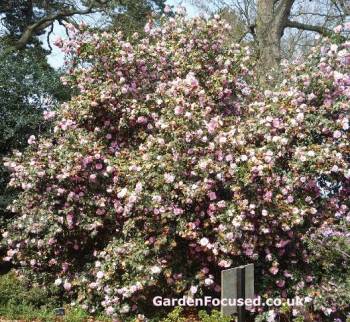
Camellia williamsii Donation in full flower
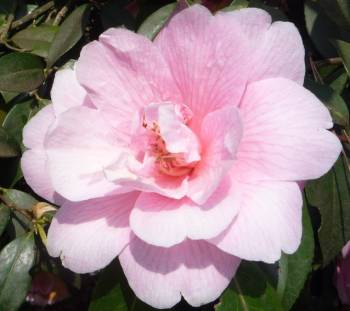
Camellia williamsii Donation single flower
WHERE TO SEE CAMELLIAS IN FLOWER
The National Collection of Camellias is held at Mount Edgcumbe Country Park in Plymouth. Their register is the ultimate list of Camellia varieties. Entrance to the park is free.
Exbury Gardens in Southampton has over 250 Camellias in its gardens. This is also a day-out destination which will keep adults and children occupied. There is a significant entry charge.
CAMELLIA SUMMARY
Below we list the key strengths and weaknesses of Camellias.
| HARDY | |
| CLAY SOIL | Yes |
| SANDY SOIL | Yes |
| DRY SOIL | Yes |
| SHADE | Partial, full sun |
| EVERGREEN | Yes |
| EASY CARE | |
| SMALL GARDENS | Yes |
| POT / CONTAINER | Yes |
| FLOWERING | |
| FLOWER TIME | Spring or autumn |
Other shrubs in this series include Ceanothus, Choisya, Hebe, Skimmia, Magnolia, Mahonia, Mock Orange, Lilacs, Potentilla and
Rose of Sharon (hibiscus syriacus). See the link below for our full list of shrubs.